Sound Research: Ryan leads effort to support military
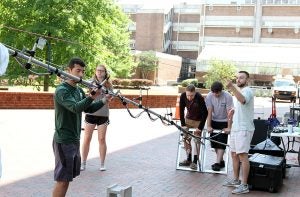
Department of Engineering students, from left, Julian Quintero-Rivera, Faith Cobb, Caleb Barber, Jamison Tyson and Thomas Albanese, prepare to erect equipment as they test acoustic equipment outside the College of Engineering and Technology. The equipment will be used later this summer as part of field study sound propagation.
Dr. Teresa Ryan learned to appreciate military service members at a young age. As a child growing up near Fort Benning, Georgia, she watched with fascination as aspiring paratroopers in the Airborne School worked on the jump towers. Today, she’s doing research that may just one day help save the lives of the service members she admires so much.
Ryan, a professor in the Department of Engineering in the College of Engineering and Technology, and some of her undergraduate students will be out in the field later this summer doing sound propagation research for the Office of Naval Research.
As part of a grant, Ryan and her students will be testing the effects temperature, humidity, wind and seas have on the distance sound travels. The real-world implications are obvious to any military member on a ship approaching an enemy coastline.
“It’s about the integrity of the mission and the safety of the personnel,” said Ryan, who was raised in a military family and whose husband was once in the Australian Navy. “If they (the enemy) hear that boat coming, they shoot at the boat, and you can lose the boat and the personnel.”
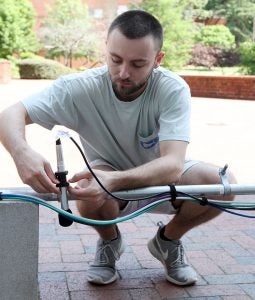
Student Thomas Albanese checks connections as he tests acoustic equipment .
Ryan and her students — including Julian Quintero-Rivera, Jamison Tyson, Caleb Barber, Kevin Davis, Thomas Albanese and Faith Cobb — will spend about five weeks this summer at the town marina in Aurora, along the Chowan River in Colerain and along the Outer Banks at the Army Corps of Engineers Field Research Facility in Duck. They’ll use an unmanned aerial vehicle (UAV) to map location and weather conditions and a nearly 23-foot-tall acoustic array with microphones that will pick up sound.
“The Navy wants to be able to know if someone on the shore can hear them coming,” Ryan said. “The way to get there is a numerical model. That will give you the likelihood that the boat is loud enough to be heard on shore.”
With so many variables — including such things as wave height, the sound of waves crashing on the shore, and wind speed and direction — that numerical model isn’t easy.
“It’s really a very complicated mathematical problem,” Ryan said.
ECU is teaming up with Catholic University of America in Washington, D.C., for the research.
The research is in its third year, and Ryan has seen positive results.
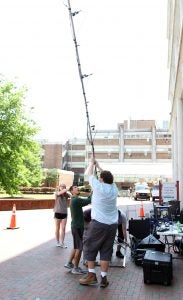
Students erect the acoustic tower.
“Does the model we have built work better than the previous one? So far, results are encouraging,” Ryan said. “We have made it better, but it’s still not good enough.”
Ryan believes several more years of research may be necessary to achieve a model that will better help the Navy make decisions on its missions.
For now, Ryan believes in the importance of the work.
“I like the project for a variety of reasons,” she said. “I’ve always been pro military and that jives with the state of North Carolina and ECU. And, it gets undergraduates involved to where they get quality research experience.”
In fact, two of her recent graduates — Matt Bogard ’16 and Chris Smith ’17 — have accepted positions at Fleet Readiness Center East at Marine Corps Air Station Cherry Point, while another — Melissa Hall ’17 — works in the Air Force Research Lab.
“They ended up with experiences that had a profound effect on where they ended up,” Ryan said. “It’s been a great project.”
-By Ken Buday, University Communications
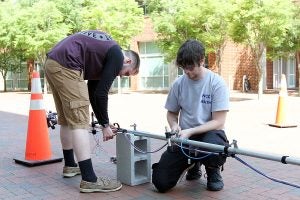
Caleb Barber, left, and Jamison Tyson, test acoustic equipment.
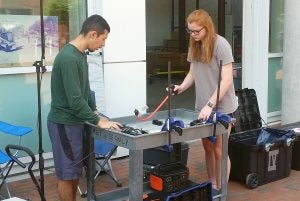
Students Julian Quintero-Rivera, left, and Faith Cobb test sound equipment.